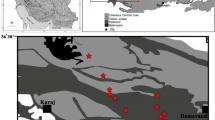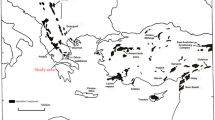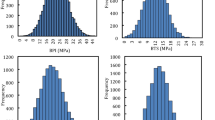Abstract
Unconfined compressive strength (UCS) of intact limestone rocks is very significant in geotechnical engineering in order to design structures that are currently being built on/in these rocks safely and economically. Obtaining core samples and testing them in laboratory according to the available standards is very expensive and time consuming. Therefore, developing novel models to predict the UCS of limestone rocks using physical properties and non-destructive tests is crucially needed. Hence, the research in this paper has been conducted to address this aim. 104 samples of intact limestone rocks have been collected from two provinces in north of Iraq (Sulaymaniyah and Mosul). The UCS, Schmidt hammer rebound number, ultrasonic pulse velocity, dry density, saturated density, and porosity have been obtained for these samples. One-dimensional regression analysis and advanced evolutionary polynomial regression (EPR-MOGA) analysis have been conducted using the obtained results. It was found that the EPR-MOGA analysis showed improved prediction performance and generally the prediction accuracy increases as the number of the variables increases. The models developed using EPR-MOGA have been compared to a simple regression equation proposed in the literature for north of Iraq limestone rocks, where it was found that the new models outperform the available correlation. The proposed models could be of significant help to practitioners when the compression testing machine is not available or when it is difficult to obtain intact samples with the appropriate length to diameter ratio. The proposed models could also serve as a tool to do independent quality control check of UCS laboratory results.
Highlights
-
Limestone rock samples have been collected from different location in north of Iraq.
-
Dry and saturated limestone rock samples have been tested in the laboratory.
-
Nondestructive and unconfined compressive strength tests have been conducted on the samples.
-
UCS cannot be accuracy estimate using one-dimensional regression analysis.
-
Novel models have been developed to predict the UCS from non-destructive tests using EPR-MOGA.















Similar content being viewed by others
Availability of data and materials
Data used in this research are available upon request.
Code availability
Code used in this research is available upon request.
References
Deer DU, Miller R (1966) Engineering classification and index properties for intact rock. Deformation Curve AFNL-TR, 65–116.
Aboutaleb S, Behnia M, Bagherpour R, Bluekian B (2018) Using non-destructive tests for estimating uniaxial compressive strength and static Young’s modulus of carbonate rocks via some modeling techniques. Bull Eng Geol Environ 77(4):1717–1728
Ahangar-Asr A, Javadi AA, Johari A, Chen Y (2014) Lateral load bearing capacity modelling of piles in cohesive soils in undrained conditions: an intelligent evolutionary approach. Appl Soft Comput 24:822–828
Alzabeebee S (2019) Seismic response and design of buried concrete pipes subjected to soil loads. Tunn Undergr Space Technol 93:103084
Alzabeebee S (2020) Application of EPR-MOGA in computing the liquefaction-induced settlement of a building subjected to seismic shake. Eng Comput. https://doi.org/10.1007/s00366-020-01159-9
Alzabeebee S, Chapman DN (2020) Evolutionary computing to determine the skin friction capacity of piles embedded in clay and evaluation of the available analytical methods. Transport Geotech 24:100372
Alzabeebee S, Alshkane YM, Rashed KA (2021a) Evolutionary computing of the compression index of fine-grained soils. Arab J Geosci 14(19):1–17. https://doi.org/10.1007/s12517-021-08319-1
Alzabeebee S, Alshkane YM, Al-Taie AJ, Rashed KA (2021b) Soft computing of the recompression index of fine-grained soils. Soft Comput. https://doi.org/10.1007/s00500-021-06123-3
ASTM D7012-14e1 (2014) Standard Test Method for Compressive Strength and Elastic Moduli of Intact Rock Core Specimens under Varying States of Stress and Temperatures. ASTM International, West Conshohocken, PA.
Azimian A (2017) Application of statistical methods for predicting uniaxial compressive strength of limestone rocks using nondestructive tests. Acta Geotech 12(2):321–333
Aziz BK, Baban EN (2005) Resistivity properties of limestone rocks in parts of Iraqi Kurdistan Region-NE Iraq. J Zankoy Sulaimani 8(1):257–267
Barone G, Mazzoleni P, Pappalardo G, Raneri S (2015) Microtextural and microstructural influence on the changes of physical and mechanical proprieties related to salts crystallization weathering in natural building stones. The example of Sabucina stone (Sicily). Constr Build Mater 95:355–365. https://doi.org/10.1016/j.conbuildmat.2015.07.131
Baykasoğlu A, Güllü H, Çanakçı H, Özbakır L (2008) Prediction of compressive and tensile strength of limestone via genetic programming. Expert Syst Appl 35(1–2):111–123
Beiki M, Majdi A, Givshad AD (2013) Application of genetic programming to predict the uniaxial compressive strength and elastic modulus of carbonate rocks. Int J Rock Mech Min Sci 1997(63):159–169
Cargill JS, Shakoor A (1990) Evaluation of empirical methods for measuring the uniaxial compressive strength of rock. Int J Rock Mech Min Sci Geomech Abstr 27(6):495–503
Cherblanc F, Berthonneau J, Bromblet P, Huon V (2016) Influence of water content on the mechanical behaviour of limestone: Role of the clay minerals content. Rock Mech Rock Eng 49(6):2033–2042
Çobanoglu İ, Celik SB (2008) Estimation of uniaxial compressive strength from point load strength, Schmidt hardness and P-wave velocity. Bull Eng Geol Environ 67(4):491–498
Daoud HSD, Rashed KAR, Alshkane YMA (2017) Correlations of uniaxial compressive strength and modulus of elasticity with point load strength index, pulse velocity and dry density of limestone and sandstone rocks in Sulaimani Governorate, Kurdistan Region, Iraq. J Zankoy Sulaimani-Part A-(pure and Applied Sciences) 19:57–72. https://doi.org/10.17656/jzs.10632
Daoud HS, Alshkane YM, Rashed KA (2018) Prediction of uniaxial compressive strength and modulus of elasticity for some sedimentary rocks in Kurdistan Region-Iraq using Schmidt Hammer. Kirkuk Univ J Sci Stud 13(1):52–67
Ebdali M, Khorasani E, Salehin S (2020) A comparative study of various hybrid neural networks and regression analysis to predict unconfined compressive strength of travertine. Innov Infrastruct Solut 5(3):1–14
Feng X, Jimenez R (2014) Bayesian prediction of elastic modulus of intact rocks using their uniaxial compressive strength. Eng Geol 173:32–40
Giustolisi O, Savic DA (2006) A symbolic data-driven technique based on evolutionary polynomial regression. J Hydroinf 8(3):207–222
Giustolisi O, Savic DA (2009) Advances in data-driven analyses and modelling using EPR-MOGA. J Hydroinf 11(3–4):225–236
Google.Map (2021) The location of the study area. Retrieved from https://www.google.com/maps/@33.8051178,46.9294439,6z?hl=en. Accessed 1 Sept 2021
Hebib R, Belhai D, Alloul B (2017) Estimation of uniaxial compressive strength of North Algeria sedimentary rocks using density, porosity, and Schmidt hardness. Arab J Geosci 10(17):1–13
ISRM (1981) Rock Characterization, testing and monitoring. ISRM suggested methods. Pergamon Press, Oxford
Jabbar MA (2011) Correlations of point load index and pulse velocity with the uniaxial compressive strength for rocks. J Eng 14:992–1006
Kahraman S (2001) Evaluation of simple methods for assessing the uniaxial compressive strength of rock. Int J Rock Mech Min Sci 38(7):981–994
Katz O, Reches Z, Roegiers JC (2000) Evaluation of mechanical rock properties using a Schmidt Hammer. Int J Rock Mech Min Sci 37(4):723–728
Kong F, Shang J (2018) A validation study for the estimation of uniaxial compressive strength based on index tests. Rock Mech Rock Eng 51(7):2289–2297
Kurtuluş C, Sertçelik FADİME, Sertçelik I (2016) Correlating physico-mechanical properties of intact rocks with P-wave velocity. Acta Geod Geoph 51(3):571–582. https://doi.org/10.1007/s40328-015-0145-1
Mahmoodzadeh A, Mohammadi M, Ali HFH, Abdulhamid SN, Ibrahim HH, Noori KMG (2021) Dynamic prediction models of rock quality designation in tunneling projects. Transport Geotech 27:100497
Mahmoodzadeh A, Mohammadi M, Ghafoor Salim S, Farid Hama Ali H, Hashim Ibrahim H, Nariman Abdulhamid S, Nejati HR, Rashidi S (2022) Machine learning techniques to predict rock strength parameters. Rock Mech Rock Eng. https://doi.org/10.1007/s00603-021-02747-x
Miah MI, Ahmed S, Zendehboudi S, Butt S (2020) Machine learning approach to model rock strength: prediction and variable selection with aid of log data. Rock Mech Rock Eng 53(10):4691–4715
Minaeian B, Ahangari K (2013) Estimation of uniaxial compressive strength based on P-wave and Schmidt hammer rebound using statistical method. Arab J Geosci 6(6):1925–1931
Mirza TA, Mohialdeen IM, Al-Hakarri SH, Fatah CM (2016) Geochemical assessment of Naopurdan limestone for cement making-Chwarta area, Kurdistan Region, NE Iraq. J ZANKOY SULAIMANI Spec Issue GeoKurdistan II:257–267
Mishra DA, Basu A (2013) Estimation of uniaxial compressive strength of rock materials by index tests using regression analysis and fuzzy inference system. Eng Geol 160:54–68. https://doi.org/10.1016/j.enggeo.2013.04.004
Mohammed DA, Alshkane YM, Hamaamin YA (2020) Reliability of empirical equations to predict uniaxial compressive strength of rocks using Schmidt hammer. Georisk 14(4):308–319
Momeni E, Armaghani DJ, Hajihassani M, Amin MFM (2015) Prediction of uniaxial compressive strength of rock samples using hybrid particle swarm optimization-based artificial neural networks. Measurement 60:50–63
Monjezi M, Khoshalan HA, Razifard M (2012) A neuro-genetic network for predicting uniaxial compressive strength of rocks. Geotech Geol Eng 30(4):1053–1062
Numan NMS, Hammoudi RA, Chorowicz J (1998) Synsedimentary tectonics in the Eocene Pila Spi limestone formation in Iraq and its geodynamic implications. J Afr Earth Sci 27(1):141–148
Ozer M, Isik NS, Orhan M (2008) Statistical and neural network assessment of the compression index of clay-bearing soils. Bull Eng Geol Environ 67(4):537–545
Sabatakakis N, Koukis G, Tsiambaos G, Papanakli S (2008) Index properties and strength variation controlled by microstructure for sedimentary rocks. Eng Geol 97(1–2):80–90
Sachpazis CI (2004) Monitoring degree of metamorphism in a four-stage alteration process passing from pure limestone to pure marble. Electron J Geotech Eng, p 416
Shahnazari H, Tutunchian MA (2012) Prediction of ultimate bearing capacity of shallow foundations on cohesionless soils: an evolutionary approach. KSCE J Civ Eng 16(6):950–957
Singh TN, Kainthola A, Venkatesh A (2012) Correlation between point load index and uniaxial compressive strength for different rock types. Rock Mech Rock Eng 45(2):259–264
Sissakian V, Ghafur AA, Omer S, Khalil D (2021) Industrial assessment of limestone beds of the Qamchuqa formation for cement industry, Kurdistan Region, North Iraq. UKH J Sci Eng 5(2):62–71
Vásárhelyi B (2005) Statistical analysis of the influence of water content on the strength of the Miocene limestone. Rock Mech Rock Eng 38(1):69–76
Wang M, Wan W (2019) A new empirical formula for evaluating uniaxial compressive strength using the Schmidt hammer test. Int J Rock Mech Min Sci 123:104094
Yurdakul M, Akdas H (2013) Modeling uniaxial compressive strength of building stones using non-destructive test results as neural networks input parameters. Constr Build Mater 47:1010–1019
Zhang W, Goh AT (2016) Multivariate adaptive regression splines and neural network correlations for prediction of pile drivability. Geosci Front 7(1):45–52
Zhang W, Zhang R, Wu C, Goh ATC, Lacasse S, Liu Z, Liu H (2020) State-of-the-art review of soft computing applications in underground excavations. Geosci Front 11(4):1095–1106
Funding
No funding was received for conducting this study.
Author information
Authors and Affiliations
Contributions
SA: conceptualization, methodology, validation, formal analysis, writing—original draft. DAM: data, experimental testing, methodology, writing—review and editing. YMA: methodology, Writing—review and editing.
Corresponding author
Ethics declarations
Conflict of interest/Competing interests
The authors declare no conflict of interest associated with this submission. In addition, the authors have no relevant financial or non-financial interests to disclose.
Additional information
Publisher's Note
Springer Nature remains neutral with regard to jurisdictional claims in published maps and institutional affiliations.
Rights and permissions
About this article
Cite this article
Alzabeebee, S., Mohammed, D.A. & Alshkane, Y.M. Experimental Study and Soft Computing Modeling of the Unconfined Compressive Strength of Limestone Rocks Considering Dry and Saturation Conditions. Rock Mech Rock Eng 55, 5535–5554 (2022). https://doi.org/10.1007/s00603-022-02948-y
Received:
Accepted:
Published:
Issue Date:
DOI: https://doi.org/10.1007/s00603-022-02948-y




